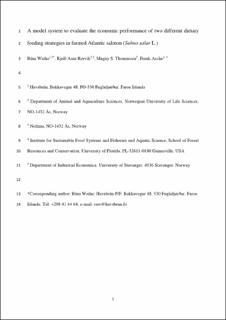| dc.contributor.author | Weihe, Runi | |
| dc.contributor.author | Rørvik, Kjell-Arne | |
| dc.contributor.author | Thomassen, Magny Sissel S. | |
| dc.contributor.author | Asche, Frank | |
| dc.date.accessioned | 2021-03-23T13:35:08Z | |
| dc.date.available | 2021-03-23T13:35:08Z | |
| dc.date.created | 2019-09-11T14:35:48Z | |
| dc.date.issued | 2019 | |
| dc.identifier.citation | Aquaculture. 2019, 512 . | en_US |
| dc.identifier.issn | 0044-8486 | |
| dc.identifier.uri | https://hdl.handle.net/11250/2735140 | |
| dc.description.abstract | This paper evaluates the feed cost differences in salmon farming based on two energy dense feed strategies: one resembles the industrial preference of using high-fat diets (LP: low protein-to-lipid ratio) whereas in the other strategy the dietary energy is to a greater degree derived from protein (HP: high protein-to-lipid ratio). Two different economical models are presented based on three different feeding experiments: one commercial large-scale and two small-scale trials. All trials were conducted with year old smolt (S1). Production costs have increased from 2009 to 2016, and the presented data depict a general increase in price of feed proteins and oils. Dietary proteins are more expensive than lipids and in isoenergetic diets, protein denser feeds are higher priced than the lipid dense alternative. HP diets lead to a higher feed deposition in carcass which results in a significantly lower feed conversion rate compared to the preferred isoenergetic LP commercial diets. Because of the improved feed-to-carcass conversion, the HP feed strategy yields a lower feed cost. In addition, the HP feed strategy induces faster growth that enables farmers to reduce the production cycle. A reduced production cycle represents an opportunity of reducing overall production costs. If improved growth is induced by dietary strategy, the reduction of overall costs should be assigned to the feed costs, i.e. a reduction of feed cost. Finally, dietary induced improvements in carcass weight yields more tradeable product which increases income. Thus, the present model system revealed that the traditional high-fat diets preferred in the salmon industry, although they are cheaper than the isoenergetic protein rich diets, are necessarily not precursors for overall lower feed costs. | en_US |
| dc.language.iso | eng | en_US |
| dc.rights | Attribution-NonCommercial-NoDerivatives 4.0 Internasjonal | * |
| dc.rights.uri | http://creativecommons.org/licenses/by-nc-nd/4.0/deed.no | * |
| dc.title | A model system to evaluate the economic performance of two different dietary feeding strategies in farmed Atlantic salmon (Salmo salar L.) | en_US |
| dc.type | Peer reviewed | en_US |
| dc.type | Journal article | en_US |
| dc.description.version | acceptedVersion | en_US |
| dc.source.pagenumber | 9 | en_US |
| dc.source.volume | 512 | en_US |
| dc.source.journal | Aquaculture | en_US |
| dc.identifier.doi | 10.1016/j.aquaculture.2019.734335 | |
| dc.identifier.cristin | 1723689 | |
| dc.relation.project | Andre: Faroese Research Foundation, Statoil Faroes & Havsbrún PF | en_US |
| cristin.unitcode | 192,10,1,0 | |
| cristin.unitname | Institutt for husdyr- og akvakulturvitenskap | |
| cristin.ispublished | true | |
| cristin.fulltext | postprint | |
| cristin.qualitycode | 1 | |

